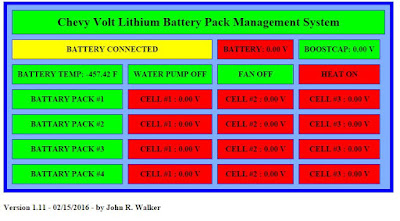Today's output was 241 AH, and Solar Controller was in Absorption for 276 minutes, but that just means the Lithium Batteries fully charge and didn't need any more power for 4.6 hours of the daylight hours today. Once the batteries reach 12.06 vols, the batteries are disconnect from the RV and the power is provided by Bootscaps and Solar Panels while the Sun is shinning.
Now lets get to the fun stuff (pictures), btw the previous blog post had more information on my project.
 |
| Battery Box Top View 21" W x 24" L x 15" H |
 |
| Battery Box Bottom View |
 |
| Old Battery Installation - Six 6V Trojan 105 |
 |
| Old Batteries Removed |
 |
 |
| Chevy Volt Batteries have liquid cooling |
 |
| When it get to hot I can open the compartment door |
 |
| Another look at plumbing |
 |
| All those wires on top are the Battery Management System (BMS) that I created. See previous post for more info |
 |
| Battery Box with lid on. No venting required, no maintenance either. |
My target voltage per cell is 4.02 volts per cell. So when my battery pack is 12.06 Volts, it is fully charge. The 4.02 volts per cell is really the 80% level. Charging to 90% is around 4.1 volts per cell, and 100% is around 4.2 volts per cell.
The batteries will last a lot longer, at 80%. The batteries are expected to last 15-20 years when charged to 80%. If you charge to 90% 4.1 volts per cell, the life drops to 7-8 years, and at 100% 4.2 volts per cell, life drops to 4-5 years.
 |
| Had Residential Fridge and Satellite Receiver running for 24 hours. |
 |
| Used 184 Amp Hours over night. |
 |
| Battery Voltage Dropped from 12.06 Volts to 11.48 Volts |
More picture can be found at Lithium Battery Project



















